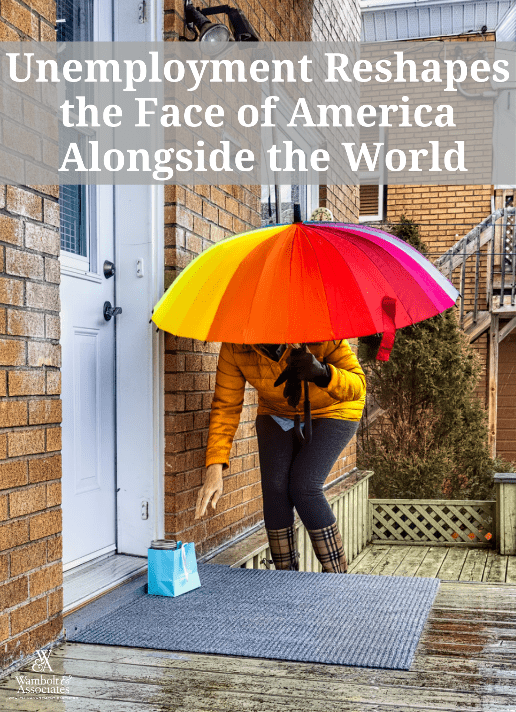
Many of us find ourselves looking to the past to find some context for what the future holds during this extraordinary time when much of America is sheltered-in at home versus managing their typically busy work life. Containment measures have led to widespread business closures and surging unemployment, resulting in more questions than answers as we are now well into five weeks of this US shutdown.
The reality lies in these unprecedented (modern) times where we have very few, if any, fair past comparisons from which to draw from when attempting to predict what lies ahead. We have more than 26 million Americans who have filed for unemployment and are without jobs. The fallout has left roughly 1 in 6 workers without a job, a number that dwarfs the 2008 Great Recession’s impact, where unemployment reached 10% by October 2009. Many economists say the unemployment rate is around 15% and could approach as much as 20%. As a point of reference, the jobless rate peaked at about 25% during the Great Depression.
So, what does re-opening the economy look like and how should one approach financial planning and income planning? Although it is human nature to seek the black and white answers wherever possible, few are often found in life. Last week the White House unveiled some general guidelines. <insert: https://www.whitehouse.gov/openingamerica/ > Each state’s governors and legislators have had a lot of latitude in terms of addressing this pandemic, which makes determining what this ‘runway’ looks like, when it begins, and how it will unfold – challenging. Clearly how New York chooses to address these challenges looks very different from other states across the country. Similarly, many countries around the world have chosen strategies that range in extremity.
For example, there are many Western countries that have enforced strict restrictions on business activities and other liberties. On the other hand, there have been a small handful of countries committed to less restrictive measures involving a combination of social distancing while focusing their efforts on their most vulnerable people with this virus (generally older and immune-compromised portions of the population).
Given the fact that viruses often evolve and come back in future waves, only time will tell which of these approaches prove more or less effective. You will find no shortage of opinions on what the future of this virus holds if you listen to the daily news. In the meantime, many of us will adapt and learn about ourselves collectively and individually throughout this process.
Low interest rates are not enough to save the day amid mandated business closures. Governments and central banks around the world have gone to extraordinary measures to address economic and market-related challenges that have been presented as a result of this pandemic. It is difficult to convey the magnitude of actions the Federal Reserve has taken to calm fixed income markets. Beyond lowering the Fed Funds rate to near zero, they have expanded their bond holdings to more than $1.6 trillion, eased bank regulations to encourage more lending, and opened up facilities to increase the flow of credit to central banks, households and businesses.
At the same time, the federal government has extended ‘lifelines’ for workers and employers to endure a period where they are not permitted to work and provide for their families via expanded unemployment benefits, the CARES Act (Paycheck Protection Program, Economic Injury Disaster Loans and grants) and a further extension of these small business loan programs to be approved by congress. It is this level of unprecedented support that impedes our ability to relate the economic outcomes of this pandemic to any past economic downturn.
While we can’t exactly agree as a nation on how to slowly and thoughtfully lift our shelter-in orders, you will find that most economists agree we have entered a recession, although there is some disagreement about how deep and long the contraction will be. Forecasts for second quarter real gross domestic product (GDP) growth range from -9% to -50% (on a quarter-over-quarter annualized basis). Economic growth in the second quarter is expected to fall sharply, resulting in the largest contraction in real GDP in the post-WWII era. Worth noting, GDP was +2.1% prior to this pandemic.
There is no question that the challenges many of us face (or will face) are extremely difficult, one silver lining is a reminder to us all in taking time out to focus on what is most important in the time we have together. How many parents feel like they have been relegated to compromising the quality of their work and parenthood to ‘hold down the fort’? With that said, it appears that many families are managing to find more true, quality time together as a side-effect – or silver lining – of quarantine.
Some children will suffer being out of the typical structure of school, while others may discover that a little more one-on-one educational attention at home unveils opportunities that would have otherwise never been recognized. At the end of the day (or the life of this virus), this whole experience is packed with countless lessons for everyone, both individually and collectively.
This virus may change how society looks at how we run our businesses or our personal home budgets. Those activities or expenditures we thought mattered pre-virus may no longer have such a stronghold post-virus. It forces us to reflect on our physical and financial health, and it raises questions about our effectiveness. It is a good time to consider a new plan based on what is learned by the vulnerabilities of the old plan.
With an eye towards being productive, we each have an opportunity to reflect on how we can enhance the lives of others as well as our own with support, problem-solving and planning. There are more people among us in need than we have seen in a very long time. One of the most constructive ways to manage through these challenging times is likely focusing our energy and efforts on the things we can control or influence, enabling us to live fulfilled and productive lives.
Sources: US Department of Labor, Charles Schwab & Co, Inc, Bianco Research LLC, Bloomberg, Moneywatch
Resource: https://www.statista.com/statistics/273909/seasonally-adjusted-monthly-unemployment-rate-in-the-us/

